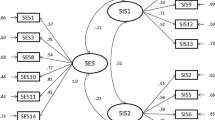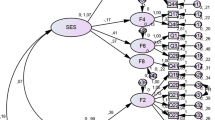Abstract
The Sexual Excitation Sexual/Inhibition Inventory for Women (SESII-W) is a self-report questionnaire for assessing propensities of sexual excitation (SE) and sexual inhibition (SI) in women. According to the dual control model of sexual response, these two factors differ between individuals and influence the occurrence of sexual arousal in given situations. Extreme levels of SE and SI are postulated to be associated with sexual problems or risky sexual behaviors. Psychometric evaluation of the original scale yielded two higher order and eight lower order factors as well as satisfactory to good construct validity and reliability. The present study was designed to assess the psychometric properties of a German version of the SESII-W utilizing a large convenience sample of 2206 women. Confirmatory factor analysis showed a satisfactory overall model fit, with support for the five lower order factors of SE (Arousability, Sexual Power Dynamics, Smell, Partner Characteristics, Setting) and the three lower order factors of SI (Relationship Importance, Arousal Contingency, and Concerns about Sexual Function). Additionally, the scale demonstrated good convergent and discriminant validity, internal consistency, and test–retest-reliability. The German SESII-W is a sufficiently reliable and valid measure for assessing SE and SI in women. Hence, its use can be recommended for future research in Germany that investigates women’s sexual behaviors and experiences.

Similar content being viewed by others
References
Bancroft, J. (1999). Central inhibition of sexual response in the male: A theoretical perspective. Neuroscience and Biobehavioral Reviews, 23, 763–784.
Bancroft, J. (2009). Human sexuality and its problems (3rd ed.). Edinburgh: Churchill Livingstone/Elsevier.
Bancroft, J., & Janssen, E. (2000). The dual control model of male sexual response: A theoretical approach to centrally mediated erectile dysfunction. Neuroscience and Biobehavioral Reviews, 24, 571–579.
Bancroft, J., Janssen, E., Strong, D., Carnes, L., Vukadinovic, Z., & Long, J. S. (2003). Sexual risk-taking in gay men: The relevance of sexual arousability, mood, and sensation seeking. Archives of Sexual Behavior, 32, 555–572.
Berner, M. M., Kriston, L., Zahradnik, H.-P., Härter, M., & Rohde, A. (2004). Überprüfung der Gültigkeit und Zuverlässigkeit des deutschen Female Sexual Function Index (FSFI-d) [Inspection of the validity and reliability of the German Female Sexual Function Index (FSFI-d)]. Geburtshilfe und Frauenheilkunde, 64, 293–303.
Bjorklund, D. F., & Kipp, K. (1996). Parental investment theory and gender differences in the evolution of inhibition mechanisms. Psychological Bulletin, 120, 163–188.
Bloemendaal, L. B. A., & Laan, E. T. M. (2015). The psychometric properties of the Sexual Excitation/Sexual Inhibition Inventory for Women (SESII-W) within a Dutch population. Journal of Sex Research, 52, 69–82.
Bostwick, W. B., Boyd, C. J., Hughes, T. L., & McCabe, S. E. (2010). Dimensions of sexual orientation and the prevalence of mood and anxiety disorders in the United States. American Journal of Public Health, 100, 468–475.
Both, S., Brauer, M., & Laan, E. (2011). Classical conditioning of sexual response in women: A replication study. Journal of Sexual Medicine, 8, 3116–3131.
Carpenter, D., Janssen, E., Graham, C., Vorst, H., & Wicherts, J. (2008). Women’s scores on the Sexual Inhibition/Sexual Excitation Scales (SIS/SES): Gender similarities and differences. Journal of Sex Research, 45, 36–48.
Carver, C. S., & White, T. L. (1994). Behavioral inhibition, behavioral activation, and affective responses to impending reward and punishment: The BIS/BAS scales. Journal of Personality and Social Psychology, 67, 319–333.
Chandra, A. (2011). Sexual behavior, sexual attraction, and sexual identity in the United States: Data from the 2006–2008 National Survey of Family Growth. US Department of Health and Human Services, Centers for Disease Control and Prevention, National Center for Health Statistics.
Evans, J. R., & Mathur, A. (2005). The value of online surveys. Internet Research, 15, 195–219.
Forbes, M. K., Baillie, A. J., & Schniering, C. A. (2014). Critical flaws in the Female Sexual Function Index and the International Index of Erectile Function. Journal of Sex Research, 51, 485–491.
Graham, C. A., Sanders, S. A., & Milhausen, R. R. (2006). The Sexual Excitation/Sexual Inhibition Inventory for Women: Psychometric properties. Archives of Sexual Behavior, 35, 397–409.
Graham, C. A., Sanders, S. A., Milhausen, R. R., & McBride, K. R. (2004). Turning on and turning off: A focus group study of the factors that affect women’s sexual arousal. Archives of Sexual Behavior, 33, 527–538.
Gunter, B., Nicholas, D., Huntington, P., & Williams, P. (2002). Online versus offline research: Implications for evaluating digital media. Aslib Proceedings, 54, 229–239.
Hammelstein, P. (2005). Die deutschsprachige Version der Sexual Sensation Seeking Scale und der Sexual Compulsivity Scale [The German Version of the Sexual Sensation Seeking Scale and the Sexual Compulsivity Scale]. Zeitschrift für Sexualforschung, 18, 135–147.
Hoerger, M. (2010). Participant dropout as a function of survey length in internet-mediated university studies: Implications for study design and voluntary participation in psychological research. Cyberpsychology, Behavior, and Social Networking, 13, 697–700.
Hu, L.-T., & Bentler, P. M. (1998). Fit indices in covariance structure modeling: Sensitivity to underparameterized model misspecification. Psychological Methods, 3, 424–453.
IBM. (2012). IBM SPSS statistics for macintosh. Armonk, NY: IBM Corp.
Janssen, E., Vorst, H., Finn, P., & Bancroft, J. (2002a). The Sexual Inhibition (SIS) and Sexual Excitation (SES) Scales: I. Measuring sexual inhibition and excitation proneness in men. Journal of Sex Research, 39, 114–126.
Janssen, E., Vorst, H., Finn, P., & Bancroft, J. (2002b). The Sexual Inhibition (SIS) and Sexual Excitation (SES) Scales: II. Predicting psychophysiological response patterns. Journal of Sex Research, 39, 127–132.
Kalichman, S. C., Johnson, J. R., Adair, V., Rompa, D., Multhauf, K., & Kelly, J. A. (1994). Sexual sensation seeking: Scale development and predicting AIDS-risk behavior among homosexually active men. Journal of Personality Assessment, 62, 385–397.
MacCallum, R. C., Browne, M. W., & Sugawara, H. M. (1996). Power analysis and determination of sample size for covariance structure modeling. Psychological Methods, 1, 130–149.
McDonald, R. P., & Ho, M.-H. R. (2002). Principles and practice in reporting structural equation analyses. Psychological Methods, 7, 64–82.
Milhausen, R. R., Graham, C. A., Sanders, S. A., Yarber, W. L., & Maitland, S. B. (2010). Validation of the Sexual Excitation/Sexual Inhibition Inventory for Women and Men. Archives of Sexual Behavior, 39, 1091–1104.
Mîndrilă, D. (2010). Maximum likelihood (ML) and diagonally weighted least squares (DWLS) estimation procedures: A comparison of estimation bias with ordinal and multivariate non-normal data. International Journal of Digital Society, 1, 60–66.
Muise, A., Milhausen, R. R., Cole, S. L., & Graham, C. (2013). Sexual compulsivity in heterosexual married adults: The role of sexual excitation and sexual inhibition in individuals not considered “high-risk”. Sexual Addiction & Compulsivity, 20, 192–209.
Musch, J., Brockhaus, R., & Bröder, A. (2002). Ein Inventar zur Erfassung von zwei Faktoren sozialer Erwünschtheit [An inventory for assessing two factors of social desirability]. Diagnostica, 48, 121–129.
Paulhus, D. L., & Reid, D. B. (1991). Enhancement and denial in socially desirable responding. Journal of Personality and Social Psychology, 60, 307–317.
Pinxten, W., & Lievens, J. (2014). An exploratory study of factors associated with sexual inhibition and excitation: Findings from a representative survey in Flanders. Journal of Sex Research. doi:10.1080/00224499.2014.882880.
R Development Core Team. (2010). R: A language and environment for statistical computing. Vienna, Austria: R Foundation for Statistical Computing Retrieved from http://www.r-project.org.
Rosen, C., Brown, J., Heiman, S., Leiblum, C., Meston, R., Shabsigh, D., & D’Agostino, R. (2000). The Female Sexual Function Index (FSFI): A multidimensional self-report instrument for the assessment of female sexual function. Journal of Sex and Marital Therapy, 26, 191–208.
Rosseel, Y. (2012). An R package for structural equation modeling. Journal of Statistical Software, 48, 1–36.
Sanders, S. A., Graham, C. A., & Milhausen, R. R. (2008). Predicting sexual problems in women: The relevance of sexual excitation and sexual inhibition. Archives of Sexual Behavior, 37, 241–251.
Strobel, A., Beauducel, A., Debener, S., & Brocke, B. (2001). Eine deutschsprachige Version des BIS/BAS-Fragebogens von Carver und White [A German version of the BIS/BAS questionnaire by Carver and White]. Zeitschrift für Differentielle und Diagnostische Psychologie, 22, 216–227.
Turchik, J. A., Garske, J. P., Probst, D. R., & Irvin, C. R. (2010). Personality, sexuality, and substance use as predictors of sexual risk taking in college students. Journal of Sex Research, 47, 411–419.
Wiederman, M. W. (1999). Volunteer bias in sexuality research using college student participants. Journal of Sex Research, 36, 59–66.
Wiegel, M., Meston, C., & Rosen, R. (2005). The Female Sexual Function Index (FSFI): Cross-validation and development of clinical cutoff scores. Journal of Sex and Marital Therapy, 31, 1–20.
Wood, J. R., Milhausen, R. R., Sales, J. M., Graham, C. A., Sanders, S. A., DiClemente, R. J., & Wingood, G. M. (2013). Arousability as a predictor of sexual risk behaviours in African-American adolescent women. Sexual Health, 10, 160–165.
Conflict of interest
None.
Author information
Authors and Affiliations
Corresponding author
Rights and permissions
About this article
Cite this article
Velten, J., Scholten, S., Graham, C.A. et al. Psychometric Properties of the Sexual Excitation/Sexual Inhibition Inventory for Women in a German Sample. Arch Sex Behav 45, 303–314 (2016). https://doi.org/10.1007/s10508-015-0547-8
Received:
Revised:
Accepted:
Published:
Issue Date:
DOI: https://doi.org/10.1007/s10508-015-0547-8




